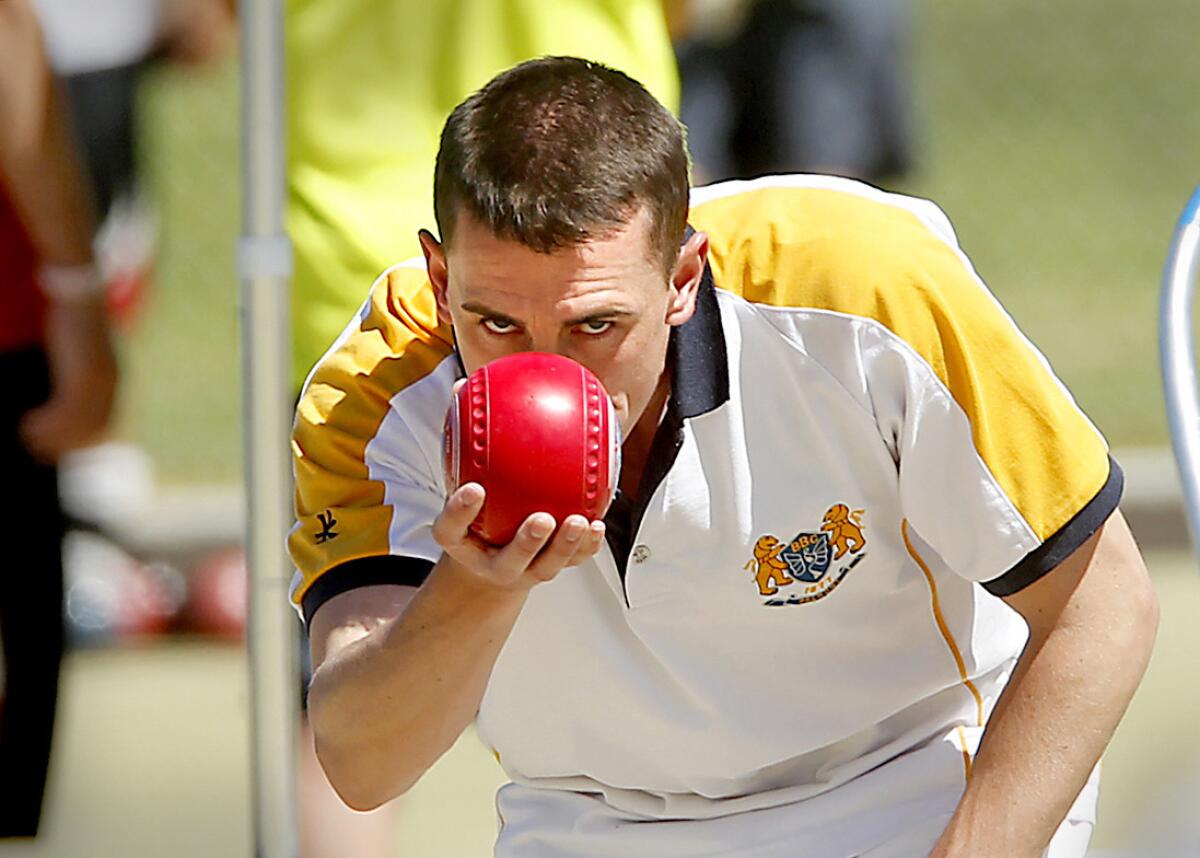Lawn bowling: Intensely competitive?

- Share via
California weather has long attracted out-of-state visitors looking to spend time outdoors. They flock to the golden coast to surf, bike and rock climb and, as it happens, “play bowls.”
More than 300 players took to the greens this week for the U.S. Open of Lawn Bowls, an annual tournament for national and international players that ends Saturday.
The only qualifications? Membership in a lawn bowling association and a small tournament fee.
This fall marks the fourth of five consecutive years that Orange County clubs, including the Newport Harbor Lawn Bowling Club, has hosted the competition.
“They thought that by doing this for five consecutive years we would eventually be able to market this game,” said Mert Isaacman, chairman of the U.S. Open committee. “To a point, we have.”
Many advocates of lawn bowling, or “bowls,” as it is affectionately known, hope to grow the sport in America among a more varied and younger crowd. More typically, as in Orange County, it is played by retirees.
The week’s intense competition would be a change for what is otherwise a largely social sport in California, but it would nonetheless demonstrate the attractive nuances of the focused game.
“Look how tight and how complicated that head is down there,” said John MacDonald, gesturing toward a match in Newport Beach on Friday. “That’s really pretty busy. That’s really a sophisticated shot down there.”
MacDonald oversees the grounds at the Newport Beach club. He ensures that the field is always fit for play, with the grass measuring at or below an eighth of an inch. Players must wear flat shoes to protect it.
“The green itself is our biggest single asset,” he explained. “It’s like one big giant golf green.”
The city used to own a lawn bowling green on Balboa Peninsula, but beginning in the 1960s, members started to grumble that they needed a new one, according to city records.
They said the group was becoming too large to fit in the space, and so they began looking for something larger.
“Over the years, many locations have been considered for relocating lawn bowling activities,” reads a 1971 report submitted to the city manager.
The Irvine Terrace Park location, where local aficionados play today, was considered a “prime” choice.
Deed restrictions at the time prevented any organized sports from being played in the area, but the determined lawn bowlers wouldn’t take no for an answer.
They launched a home-to-home poll of residents in the Irvine Terrace area. A two-hour hearing on the topic in February 1971 ultimately cleared the way for the bowlers to make their move. The Irvine Co. donated the space, and the city spent $40,000 to help develop it.
“We will now be able to encourage and accept many new members,” D.T. Tarbox, the club’s president at the time, wrote to the Newport Beach City Council in thanks
On Sept. 21, more than 100 players from across the world walked onto that very property to attend the opening ceremonies. The club itself now boasts more than 300 members, who each pay $175 in annual dues.
Introductions and thank yous were given at an otherwise laid-back affair, as attendees sipped canned beers and low-cost Franzia wine in plastic cups.
Newport Beach Mayor Keith Curry, clad in a wide-brimmed hat, rolled the first bowl.
“If you’re going to throw out the first pitch of the year, make sure it’s not your first pitch that year,” said Curry, admittedly not a regular player, who had shown up early to practice at the club.
At first glance, the sport’s aim seems simple. One wants to roll a “bowl,” which resembles a small sphere that has been slightly stomped on, down a grassy strip so that it lands as close as possible to the “jack,” a smaller, yellow ball positioned at the opposite end of the 120-foot playing area.
But a number of elements make this difficult. Environmental conditions constantly change. The wind, the length of the grass and the sunlight, for example, vary based on the time and location of play.
Then there is the game itself.
The resin bowls are “biased,” meaning they have been weighted to one side.
As a result, a bowl cannot be thrown straight. More likely, a bowl rolls directly forward about two-thirds of the way, curves one way or another, wobbles, and falls onto its side.
Anywhere between one and four players compete in a match. Each bowler is allotted accordingly a certain number of “bowls” to use, and shots are alternated among players.
Even if one does manage to roll the perfect shot, it could be ruined within moments. A bowl that lands right next to — or, as they say, “on top of” — the jack could be knocked away by the next player’s toss.
“There’s all kinds of little nuances like that involved in the game,” MacDonald said.
The constant focus and adjustment, players believe, should appeal to any age level. Men can compete equally against women, as can the old against the young — assuming more start to show up.
[For the record, 4:20 p.m. Sept. 30: In a previous version of this story, the event was incorrectly referred to as the U.S. Open of Lawn Bowling. It is actually called the U.S. Open of Lawn Bowls.]